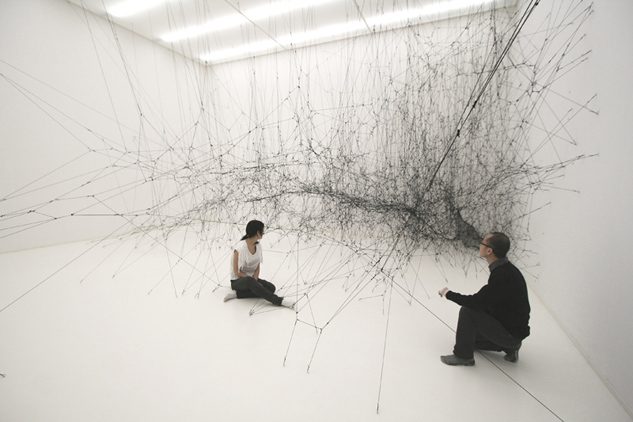Tomás Saraceno occupies the entire gallery with his utopian installations, which combine science, art and architecture. This is the first major presentation of this internationally renowned artist in Europe.
In collaboration with arachnologists (spider scientists) and astrophysicists, Tomás Saraceno has spent several years developing the 400 cubic metre installation exhibited at Bonniers Konsthall. His new work is an enormous model of the web of a black widow – a poisonous spider – and is inspired by how scientists utilise images of spiders’ webs to describe the origin and structure of the universe. The gigantic spider web, custom-made for the main gallery of Bonniers Konsthall, comprises black elastic rope stretching from the floor to the ceiling. The new work is accompanied by drawings, photographs and texts which provide a unique insight into Tomás Saraceno’s working process and artistic world. In addition, the exhibition includes 15 of his previous works.

Tomás Saraceno has studied both art and architecture. Employing techniques such as installation, sculpture and photography, the artist explores the organic conditions and structures of our world. His work takes the form of anything from balloons and inflatable constructions to flying gardens, floating bridges and futuristic living spaces. Inspired by architects and theoreticians such as Richard Buckminster Fuller, Peter Cook and Yona Friedman, Tomás Saraceno examines how scientific innovations can develop new ideas for a more sustainable society. Tomás Saraceno’s work comprises concepts of how art may build dreams for the future. He has the courage to let art propose new utopias in harmony with architecture and science.
A spider’s web and the human city network (…) are both simultaneously many other things. As with all nets, they possess the possibility to both keep out and exclude, as well as trapping and containing. This is very much in the same vein with floating space stations’ portrayal of the earthly city inhabiting a space between freedom and stuffiness, between helplessness and absolute power.
Helena Granström on Tomás Saraceno

Tomás Saraceno according to…
18 April
Helena Mattsson, architect and lecturer in architectural theory and history, KTH Royal Institute of Technology
9 May
Lars Bergström, professor in the Physics Department, Stockholm University
23 May
Helena Granström, author and mathematical physicist